Picture some of the most beautiful gardens that you’ve ever seen. Chances are, many of them had a Japanese maple or two (or three). That’s because these trees are so incredibly unique, elegant, and colorful.
Plus, there are so many size, shape, and growth combinations available, you’re sure to find what you need to add height, texture, or color to a garden display.
Chances are, if you need a small tree to add interest to your own garden, there’s a Japanese maple that fits the bill.
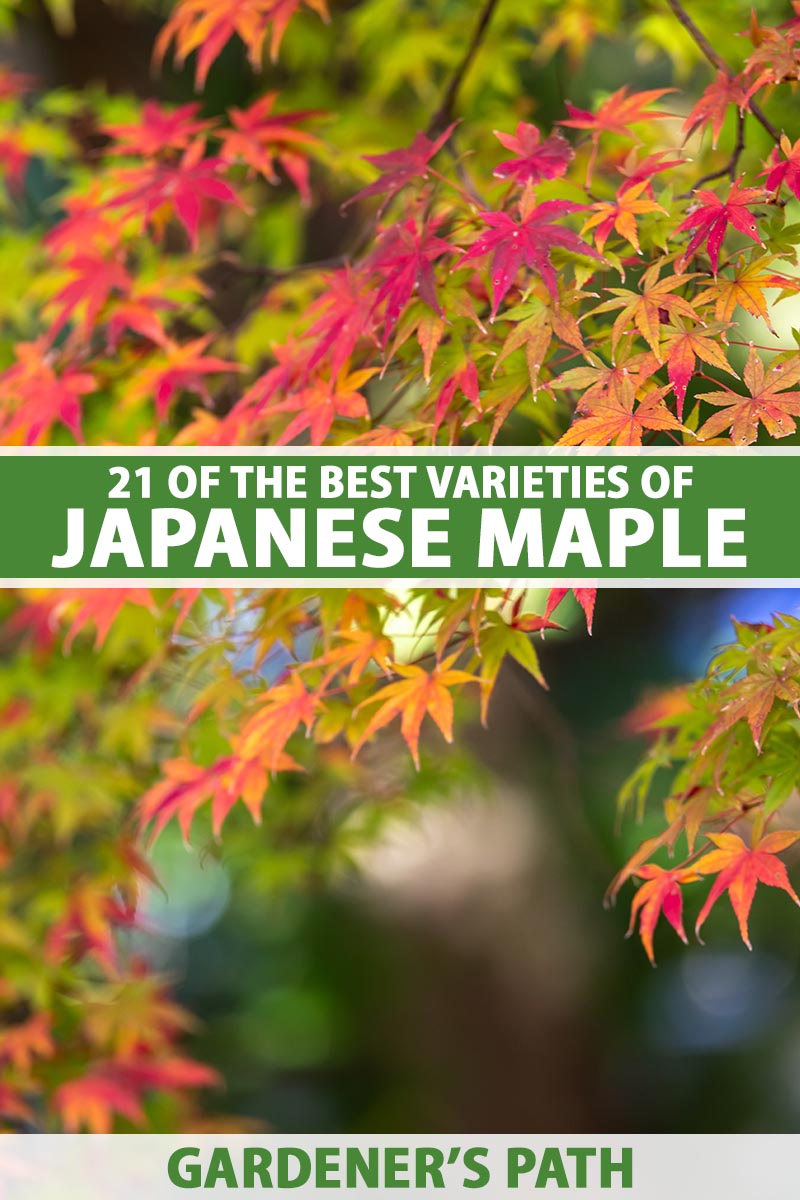
We link to vendors to help you find relevant products. If you buy from one of our links, we may earn a commission.
That said, the marvelous variation available is also what makes shopping for one of these trees a bit challenging. A well-stocked nursery can be downright overwhelming!
This guide will help you to narrow down the search. Up ahead, we feature some of the best options out there.
Whether they are particularly hardy, exceptionally beautiful, or one of the more popular or unique trees out there, there’s something on this list for everyone who is in the market for a Japanese maple to grow at home.
Here are the trees you’re about to learn all about:
21 Favorite Japanese Maple Varieties
There are some pretty incredible trees on this list, so let’s jump right in!
1. Autumn Moon
Obviously, I love all my Japanese maple children equally. But if there is one tree that I tend to show off just a bit more than the others, it’s A. shirasawanum ‘Autumn Moon.’

This upright tree stays fairly compact, topping out at about 12 feet, though it takes years to reach that point. But its size isn’t its most exceptional aspect.
The foliage is the real knockout feature.
In the spring, it’s yellow and orange before shifting to salmony-red during the summer. In the fall, it changes to vibrant orange and red.
And rather than having the familiar deeply lobed leaves that you’ll see on many Japanese maples, the leaves on this tree look like large palms with seven or nine stubby “fingers.”
It grows best in Zones 5 to 8, and needs full sun to really show its color.
You can find ‘Autumn Moon’ plants in one- and three-gallon containers available from Maple Ridge Nursery.
2. Beni Kawa
A. palmatum ‘Beni Kawa’ isn’t just beautiful when it’s dressed up in its full summer foliage. It has bright coral-colored bark that makes a striking statement in the winter garden as well.
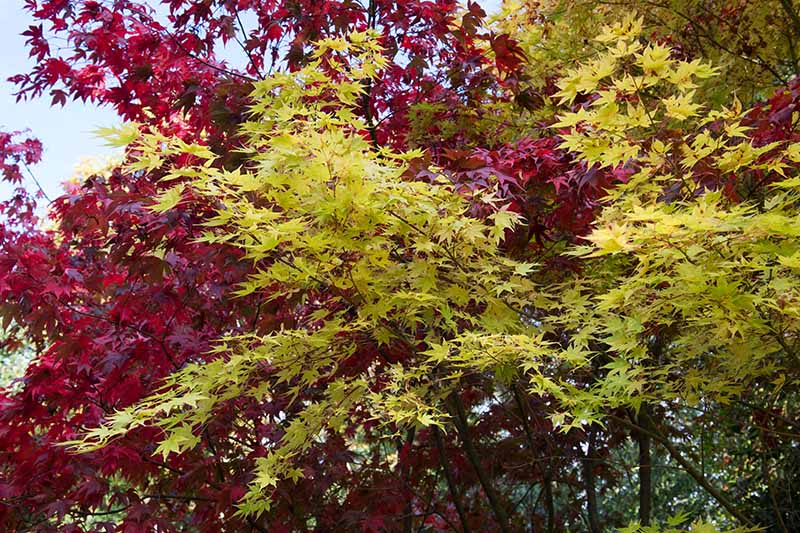
The leaves start out with a bright green color in the spring, gradually transitioning to golden yellow in the fall.
At under 10 feet tall and wide, it won’t crowd out the rest of the plants in your landscape. It also has a lovely arching growth habit.
‘Beni Kawa’ thrives in warmer areas than some other cultivars, and it’s suited to Zones 5 to 9.
You can purchase plants from Maple Ridge Nursery.
3. Butterfly
A. palmatum ‘Butterfly’ stands out because it has medium-green leaves with distinct silvery white margins.
And some leaves may be entirely green while others are entirely silvery white, giving the entire tree a lovely variegated appearance.

That’s not all, though. In the spring, new growth is pink on the margins, while in the fall, the margins of the deeply lobed leaves turn bright magenta. It’s an impressive sight.
‘Butterfly’ needs partial sun and only grows in Zones 6 to 8. When mature, it reaches up to 12 feet tall and eight feet wide with an upright growth habit.
You can find two- to three-foot ‘Butterfly’ plants available for purchase at Fast Growing Trees.
4. Coonara Pygmy
A. palmatum ‘Coonara Pygmy’ stays petite, only growing to about ten feet tall – about half the size of some larger Japanese maples – with an upright habit. It’s hardy in Zones 6 to 9.
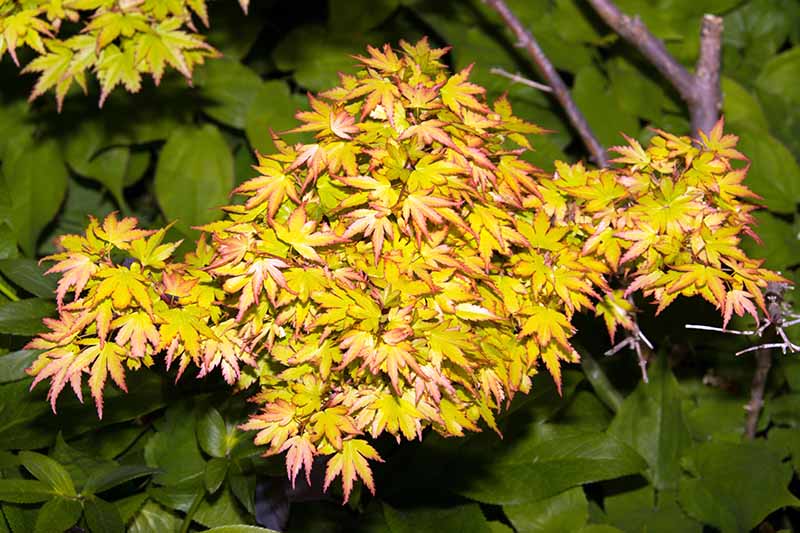
The deeply lobed leaves are pink as they first emerge in the spring before turning bright green in the summer. In the fall, the foliage becomes bright red with small patches of yellow.
Pick up ‘Coonara Pygmy’ in one- and three-gallon containers at Maple Ridge Nursery.
5. Coral Bark
A. palmatum ‘Sango Kaku’ is another Japanese maple with bright coral bark. Its name means “coral tower.” The color becomes more intense as the seasons become cooler.
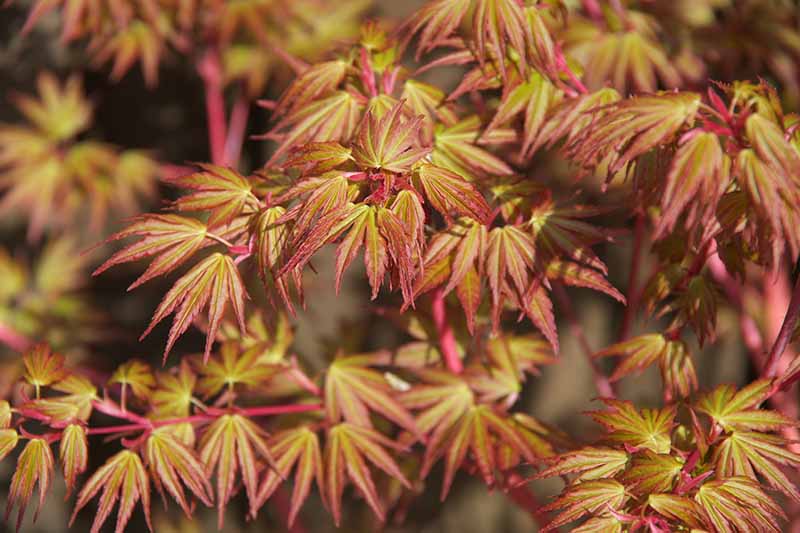
Hardy in Zones 5 to 8, the leaves on this tree are bright green with red margins in the summer, turning brilliant yellow in the fall.
Once mature, this striking tree stands with an upright habit at 20 to 25 feet tall.
‘Sango Kaku’ is ideal if you want something that not only adds color to the yard during the growing season, but also during the dormant winter months.
Sound good? Nature Hills Nursery carries this plant in #2 containers.
Read more about growing coral bark varieties here.
6. Crimson Queen
An incredibly popular tree, ‘Crimson Queen’ is a dwarf A. palmatum cultivar.
It’s wider than it is tall, eventually growing to about eight feet tall and 12 feet wide, with elegantly weeping branches. Its shape can add some interesting dimension to your garden.
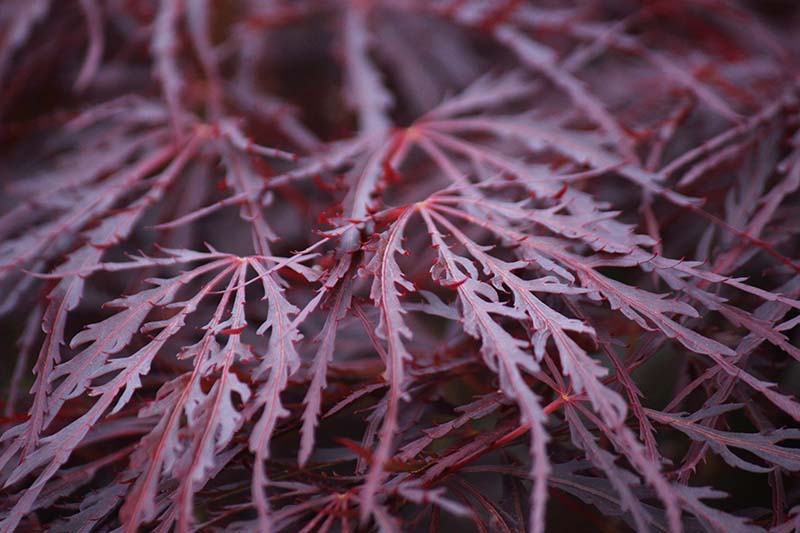
The foliage can appear to have a different hue depending on the amount of light it receives. In partial sun, the lacy leaves are maroon.
In spots that receive more light, the color is a brighter red. In the fall, the foliage becomes a dazzling crimson.
‘Crimson Queen’ is hardy in Zones 5 to 9. To nab one for your yard, head to Nature Hills Nursery, where you can purchase a three-year-old plant.
Find growing and care tips for this cultivar here.
7. Emperor One
This cultivar looks similar to the exceptionally popular ‘Bloodgood,’ but differs in that it only grows to about 15 feet tall with an upright growth habit. It’s hardy in Zones 5 to 8.
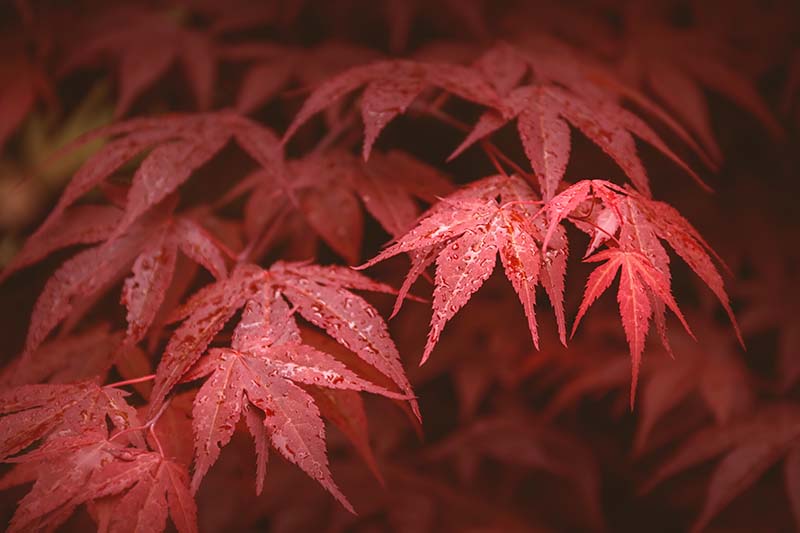
This A. palmatum cultivar is one the hardiest maples out there, rarely suffering from pests and diseases.
The foliage is stunning, transitioning from deep maroon to bright red in the fall.
Our friends at Nature Hills Nursery carry this beauty in #2 containers.
8. Green Cascade
A. japonicum ‘Green Cascade’ is an upright full moon maple that grows in Zones 5 to 7, and reaches about 20 feet tall and 25 feet wide.

With rounded and palmate foliage, somewhat resembling a fern, the deeply lobed and heavily serrated emerald green leaves turn bright red and yellow in the fall.
In the garden, the effect is extremely impressive. It’s almost like having a massive, shade-providing fern in your garden.
‘Green Cascade’ is available in one-, three-, seven-, 15-, and 25-gallon containers at Maple Ridge Nursery.
9. Higasayama
While Japanese maples tend to really shine in the fall when their foliage turns to a different hue, ‘Higasayama’ also puts on an elegant display in the spring.
The leaves bud out with a green base enveloped in a bright pink exterior.

As the leaves open, they reveal a creamy pink display before turning deep green with creamy margins. This A. palmatum is happiest in Zones 5 to 8, with an upright, open growth habit that tops out at about 18 feet tall.
Japanese Maples and Evergreens via Amazon carries this spectacular tree as a two-year-old plant if you’re itching to add it to your space.
10. Hogyoku
Gardeners in Zones 5 to 9 can grow this elegant A. palmatum, also known as the “Golden Jewel of Fall.”
While ‘Hogyokou’ is beautiful all summer with its green, yellow, orange, and slightly red-tinged leaves, it’s the bright pumpkin orange color it displays in the fall that really stands out.
This upright tree is medium-sized when mature, at about 15 feet tall and 10 feet wide. This is a cultivar that does better in full sun than many others.
If you’re dying to get your hands on ‘Hogyoku’ – and I can’t blame you – head on over to Maple Ridge Nursery.
11. Koto Ito Komachi
No guide to Japanese maples would be complete without the lovely, classic A. palmatum cultivar ‘Koto Ito Komachi.’
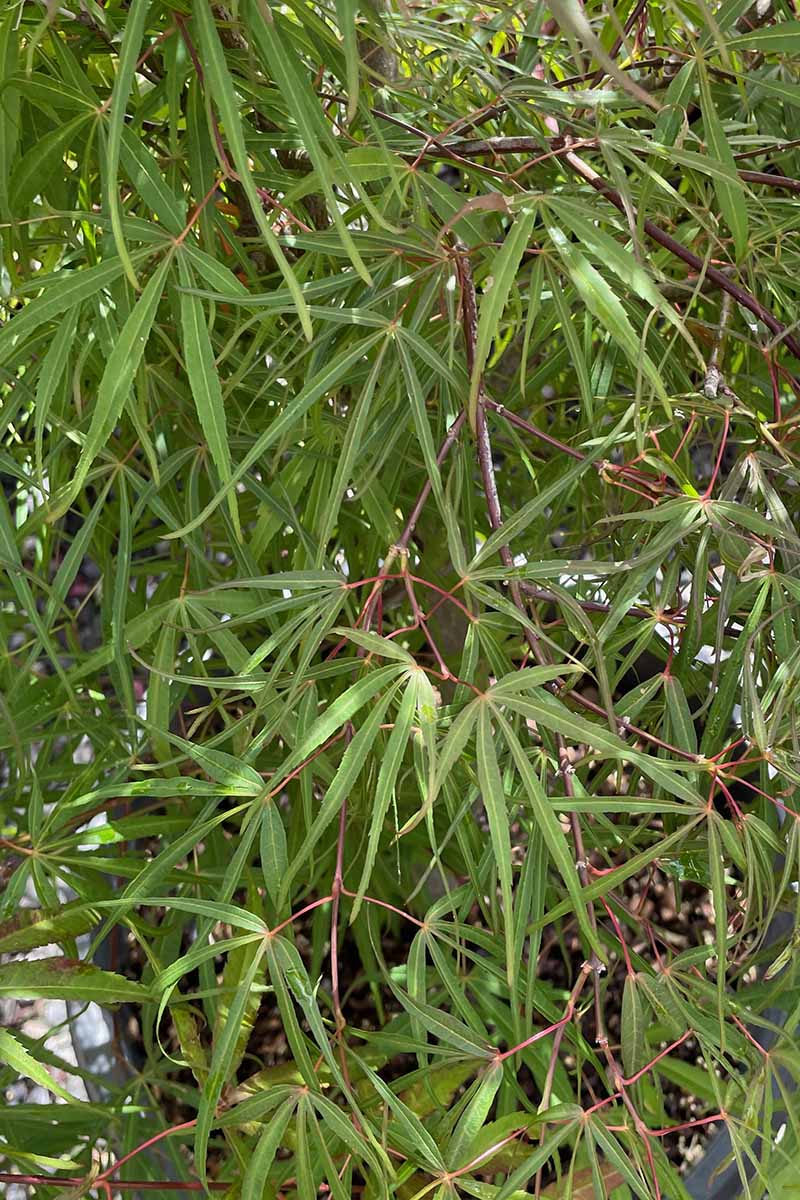
The leaves on this tree have five string-like lobes and are light green in the summer before turning bright orange in the fall.
It almost resembles a tiny weeping willow, and grows upright to just six feet tall and five feet wide when mature.
Hardy in Zones 6 to 9, you can grow it in Zone 5 if it’s in a protected spot.
You can find ‘Koto Ito Komachi’ in starter pots and three-gallon containers at Maple Ridge Nursery.
12. Lion’s Mane
A. palmatum ‘Shishigashira,’ also known as ‘Lion’s Mane,’ doesn’t look like your average maple. The leaves grow packed close together and they’re a deep, glossy green with wrinkled margins.
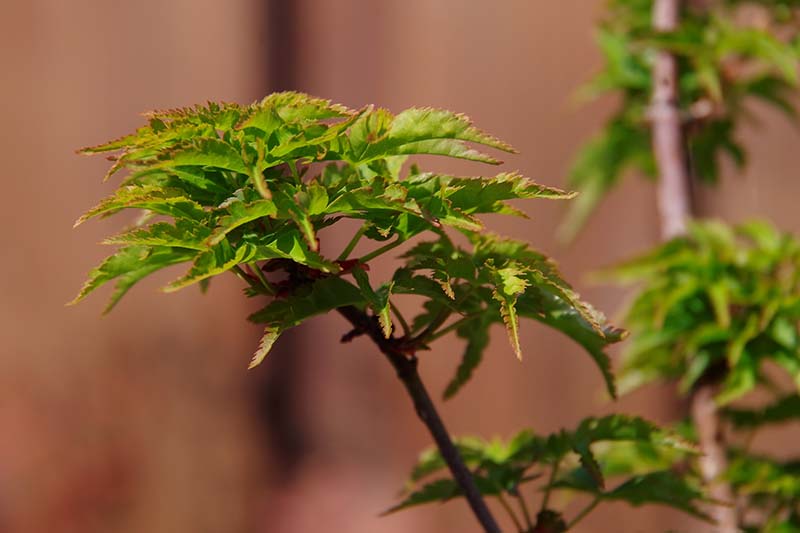
At summer’s end and into fall, it gradually turns yellow and orange.
‘Lion’s Mane’ stays under six feet tall with an upright habit, and is hardy in Zones 6 to 9. The leaves may burn at the tips if grown in direct sun in hot climates.
You can pick up plants in one-, three-, seven-, 15-, and 25-gallon containers at Maple Ridge Nursery.
13. Osakazuki
For fall color, it’s hard to beat ‘Osakazuki.’ This A. palmatum tree has intensely bright orange-scarlet leaves in the autumn that stay on the tree for several weeks.
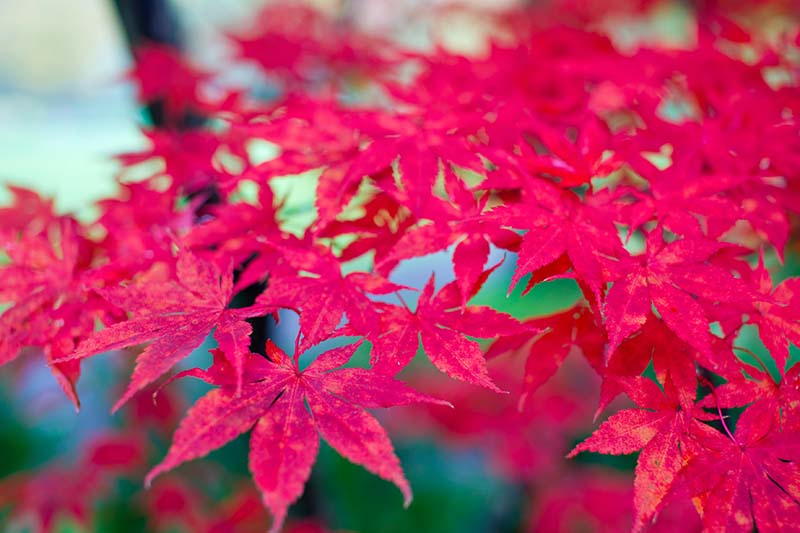
In spring and summer, the leaves are bright green. Each leaf has seven lobes and serrated edges.
‘Osakazuki’ won the Royal Horticultural Society Award of Garden Merit in 1993.
Best suited to Zones 5 to 8, it grows up to 25 feet tall and 15 feet wide with an upright, rounded shape.
Maple Ridge Nursery carries ‘Osakazuki’ in a variety of different sizes.
14. Red Dragon
Hardy in Zones 5 to 8, the popular ‘Red Dragon’ is compact with a tidy, weeping growth habit. This A. palmatum cultivar stays extremely small, just six to eight feet wide and tall when mature.
But what really makes ‘Red Dragon’ stand out is its stunning foliage color in the fall.
The summer hue is an extremely dark burgundy, changing to a luminescent red in autumn that practically glows from within.
Add some color to your yard by purchasing a plant from Maple Ridge Nursery. Choose from one-, three-, seven-, 15-, and 25-gallon containers.
15. Scolopendrifolium
If you want something a little different, get your hands on ‘Scolopendrifolium,’ also known as ‘Shinobuga Oka.’
The leaves on this A. palmatum tree have incredibly long, narrow lobes that are divided down to the base.
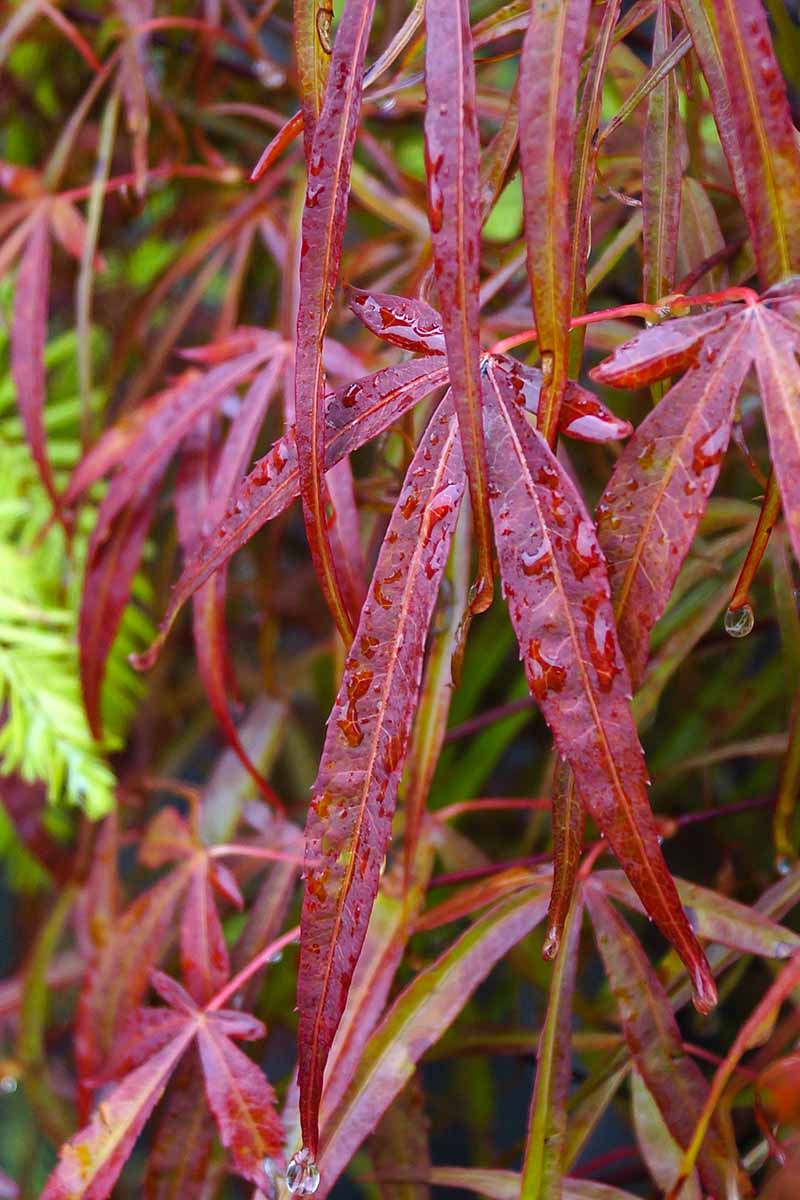
In the summer, the leaves are bright green, while the stems, seed pods, and blossoms are all red. The overall effect is impressive.
This upright, spreading, 15-foot tree appears to be covered in delicate green straps with the red adding a striking contrast, and it grows well in Zones 5 to 9.
16. Seiryu
Every single other green lace-leaf maple that we know of has a weeping or cascading growing habit. ‘Seiryu’ is credited as being the only strong upright grower with green lacy leaves.

It doesn’t grow terribly tall, staying under 15 feet, but it usually maxes out closer to 10 feet.
‘Seiryu’ is suited to Zones 5 to 9, and does best in part shade, since full sun can singe the leaves. The foliage is bright green in the spring and summer, turning golden yellow with red tips in the fall.
Add this variety to your yard by purchasing a tree in a one-, three-, or 15-gallon container from Maple Ridge Nursery.
17. Usugumo
If you want a maple that will really stand out, seek out A. pictum ‘Usugumo,’ a rare painted leaf batwing maple.
This leaf shape isn’t common and it looks nothing like the deeply-lobed foliage that most people are familiar with.

In the spring, this stunner emerges with soft pink leaves that change to green in the summer.
From far away, the leaves look like they are a uniform soft, pale green, but up close, you can see that they are actually variegated.
Each leaf has a deep green base with green veins, and cream or pale yellow mottling. In the fall, the leaves turn pale yellow.
This upright tree does best in Zones 5 to 9 and is perfect for a small space or container. It never grows taller than about seven feet.
18. Velvet Viking
This gorgeous A. palmatum specimen may look delicate with its lovely lacey leaves, but it’s actually quite sturdy, and it is hardy in Zones 4 to 9.
A dwarf cultivar, ‘Velvet Viking’ has an elegant weeping form, spreading low and wide. At maturity, it reaches only three feet tall and five feet wide.
The purple-red foliage turns an intense, bright red in the fall.
19. Villa Taranto
This A. palmatum dwarf variety has red, green, and cream-colored variegated leaves, and has an upright vase-shaped growing habit.

The foliage is deeply lobed so that each leaf almost looks like it has five or more string-like fingers.
It does well in Zones 5 to 8, and can be grown in full sun in cooler areas, or part shade in hotter spots.
If this maple is calling your name (and I totally understand), head on over to Maple Ridge Nursery to grab a tree in a one- or three-gallon container.
20. Viridis
If you want a lacy, green A. palmatum Japanese maple that you can grow in a container or a small area, ‘Viridis’ is an excellent choice.
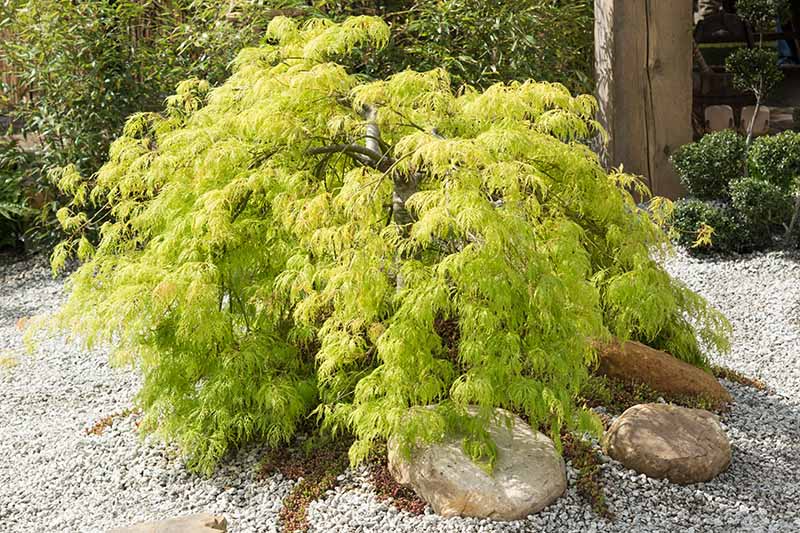
It only grows to six feet tall and wide, but can easily be pruned to stay about four feet tall and three feet wide. Its growth habit is a gracefully mounding cascade.
The foliage is deeply lobed with heavily toothed margins in a marvelous deep shade of green that transitions to orange, yellow, and red in the autumn.
Pick up your own two-year-old live tree at Nature Hills Nursery.
21. Vitifolium
A. japonicum ‘Vitifolium’ has foliage that almost looks like grape leaves, which turn intensely gold and scarlet in the fall. In the spring, they are bronze as they emerge and open, at which point they begin to turn a vivid green.
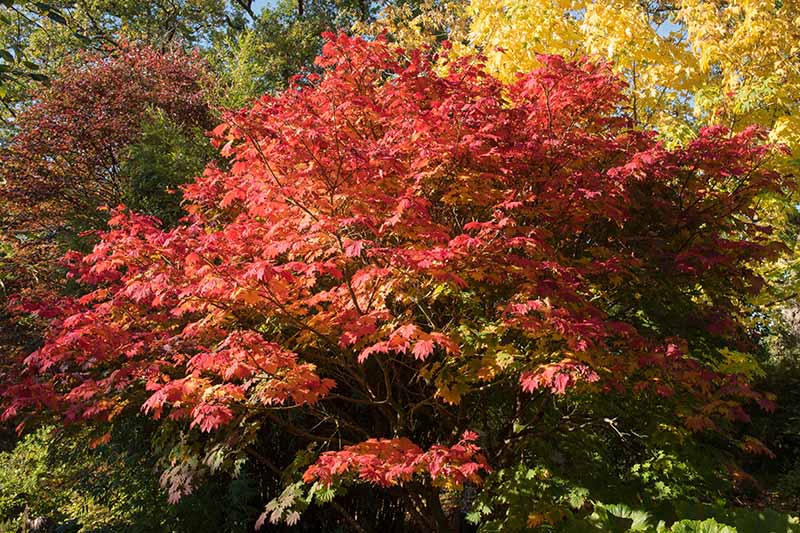
Plus, it has beautiful burgundy flowers in the spring. Most maples aren’t noted for their blossoms, but this one is because of the way the blooms stand out against the bright green foliage.
‘Vitifolium’ won the RHS Award of Garden of Merit in 1993. It grows with an upright habit to 15 feet tall and wide, and is hardy in Zones 5 to 7.
Sold? You can’t go wrong with this beauty. You can find plants available in one-, three-, seven-, 15-, and 25-gallon containers at Maple Ridge Nursery.
There Are So Many Japanese Maples to Love
We weren’t kidding when we said there are a ton of different Japanese maples to choose from!
This really is an incredibly varied group of trees, and that’s part of their charm. But now, you hopefully have a better idea of which one is perfect for your space.
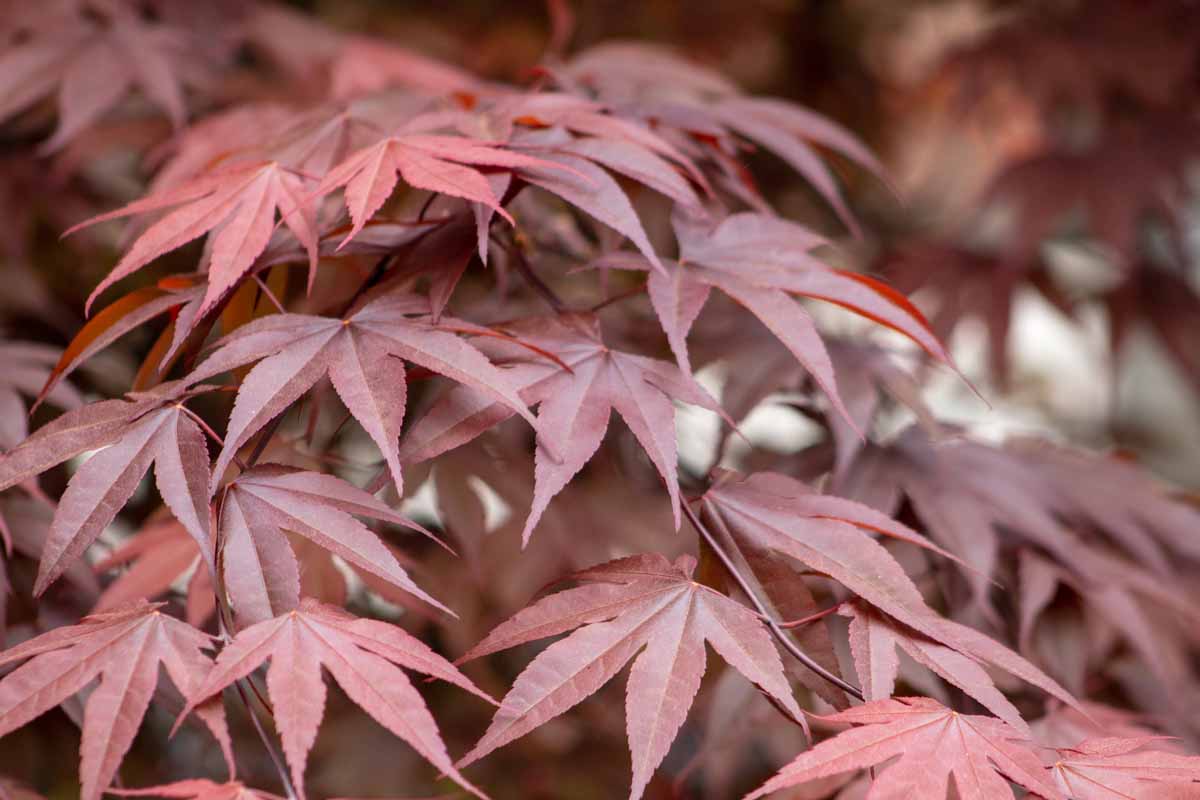
If so, I genuinely want to hear about which one you end up picking for your garden. Pictures, too, please! Reach out below in the comments.
And for more information about Japanese maple trees, check out the following guides next:
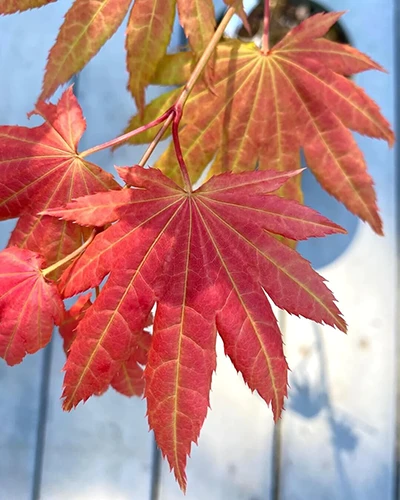
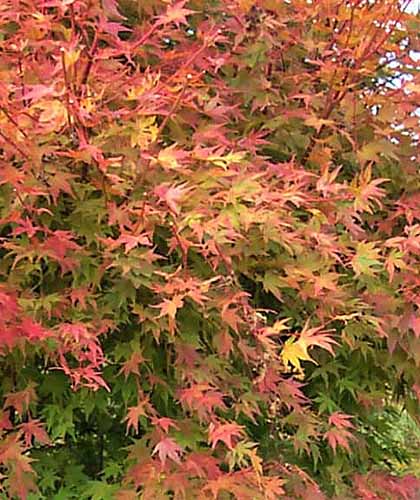
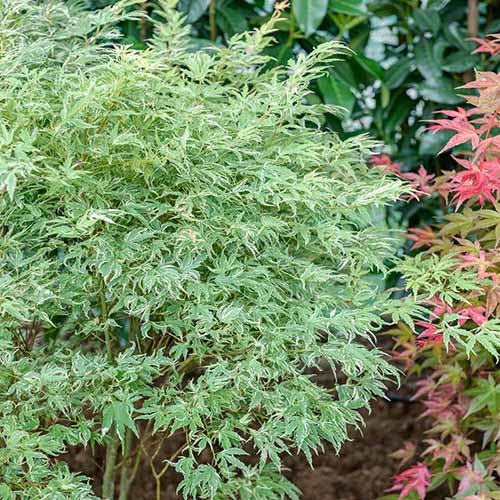

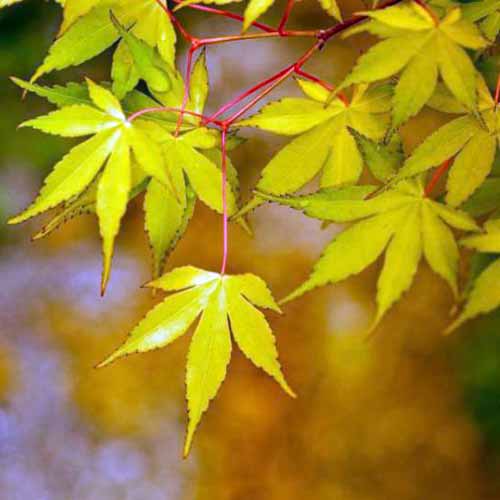

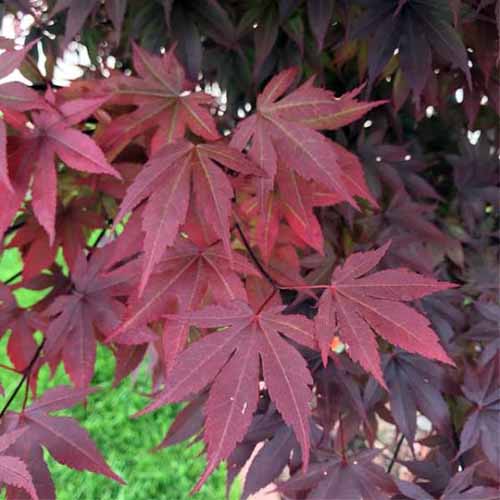

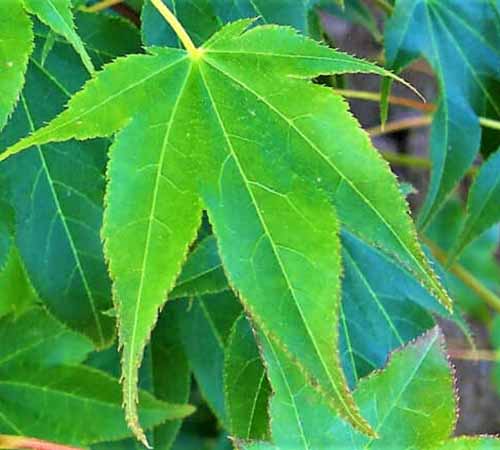
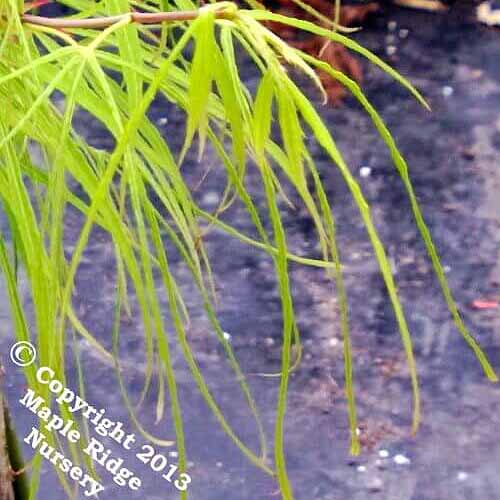
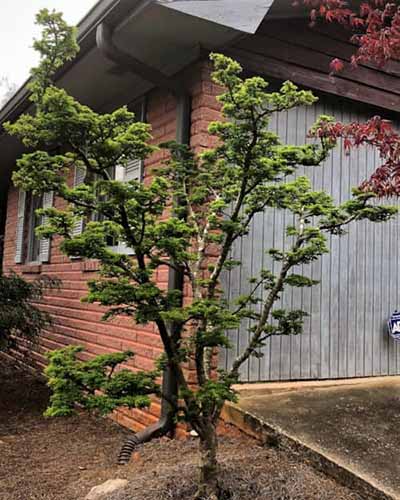
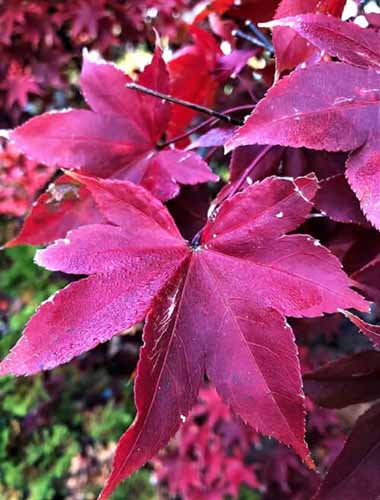
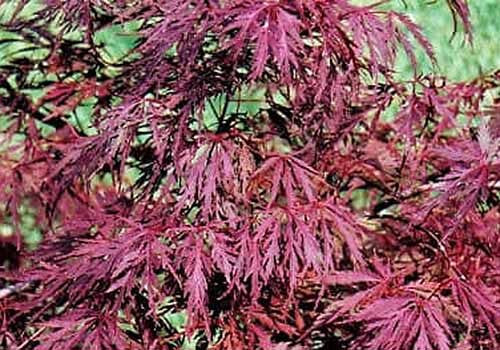

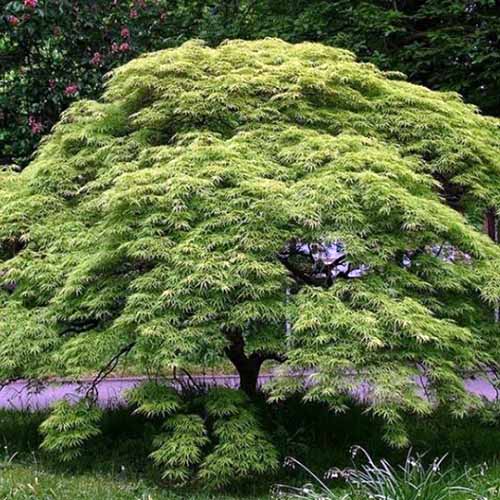
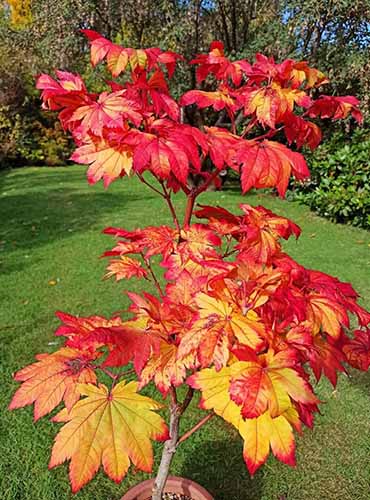
What is the true name of a Japanese Maple that they advertise as a Waterfall
Japanese Maple? It’s green and turns red in the fall. Also, same thing for the Orangeola. Thanks
Waterfall Japanese maples are classified as Acer palmatum var. dissectum ‘Waterfall.’ The ‘Orangeola’ is another A. palmatum variety. Both are lovely for fall color.
Do you know the name of the Japanese maple that shapes like a vase? Starts small at the bottom the branches out larger as it ages.
There are many Japanese maples that have a vase-shaped growth pattern. Some of the trees with the most distinct vase-like growth are ‘Sango Kaku,’ ‘Beni Kawa,’ and ‘Autumn Moon.’
I planted an Autumn Moon three years ago this late spring. It is in full sun (noon to 5:00), in zone 7a. It is healthy enough with a little burning (not much) in summer. The issue is that it has hardly grown at all. I read varying opinions on whether it should be planted in full sun. I need to know if I should move it to part sun or just be patient and leave it where it is.
Hi Linda, sorry for the delayed response. I would actually consider your tree to be in partial sun now. Full sun would be closer to 6+ hours per day. Where you have it should be perfect, actually. They can handle more sun, but you will see leaf burn during the summer. It won’t kill the plant, but it’s a little ugly. I would recommend keeping it where it is for now. Usually, I find that Japanese maples tend to take off in their fifth year or so.
Hey Linda, saw this and thought i would share. My crimson queens did not grow for 3 years and one year I decided to trim the ends and put a little fertilizer and its grown exponentially. Also, one of them the water was running off and not actually soaking the ground, so i created a slight deeper circular area around the base so the water would sit and be absorbed. The growth ias insane and very fun to watch. One side has grown 2 new branches that reached about a foot in length in about a month.
Hi
Could you please telt me which Japanese Marple is shown in the very first picture, behind the text’ ’21 OF THE BEST JAPANESE MAPLE VARIETIES’?
Thank you for your article.
With best wishes
Jan
Is your book in print? How could I get your book?
Thanks for your interest, Janet. At this time, our publications are only available via our website.
HI,
Do you by any chance know which varieties of Japanese maples were popular in the early 1950s? I’m trying to research what sort of Japanese maple was on my property. An arborist hired to take care of another tree cut it down and now he’s arguing with me that it was just a regular old maple. It towered over my shed, probably twice as high as it, (maybe 16ft?). The leaves look like it could be an Emperor One. I live in Virginia if that helps. Many thanks!
It’s hard to say, but ‘Bloodgood’ has been popular since the 1930s and looks similar to ‘Emperor One.’ ‘Yezo Nishiki’ and ‘Nomura Nishiki’ were also fairly common in the 50s and have a similar look. You might also consider ‘Thunberg.’
Hey can someone help me identify this japanese maple? I planted it about 5 years ago near my pond, but a willow bush started to steal it’s sunlight, so I moved it to a new bed. I don’t know what it’s growth habit will be and i’m having trouble identifying it’s type. Any help would be appreciated!
So the photo attachment feature is not working, but it has bright green leaves, that are beginning to be tinged with red.
Hi Paige, it might help us narrow things down if we knew what color the foliage is in the spring. For instance, Corallinum types are pink in the spring. Otherwise, I’d guess that this is an Amoenum type. The most popular Amoenum type that looks similar to the picture you provided is ‘Osakazuki,’ which we discuss above.
For an explanation of the different types, head to our guide.
Is it possible 2 underplant, Jap. Maples, (SUCCESSFULLY), w Ericaceae, ((Azalea, Calluna/Erica, Pieris,
Rhodo. Etc.) ???
Hi Harry – absolutely! In my neck of the woods, you see rhodies or azaleas together with Japanese maples in practically every yard. Just be thoughtful about the cultivars you choose. Pick a taller maple and a shorter understory plant. Coastal azaleas are particularly well-suited.
I have either a crimson queen or a red dragon. Leaves are on the purple side. This season it opened beautifully as every other season and then I started to notice the leaves were looking good to the point they were drying up and falling off. I have been given water as suggested but still nothing is happening. Not sure what to do at this point, we haven’t had rain here in over a month hence why I have been giving it water. Do you think it needs fertilizer?
Hi Dennis, how long ago did you plant it? When is the last time you fed it? I doubt the problem is a lack of fertilizer. How much sun is the plant receiving in the afternoon? In times of drought and heat, the leaves are more susceptible to sun scald, which can cause the symptoms you’re talking about. Try to keep the soil regularly moist but not wet during the dry periods. The top few inches of soil can dry out between watering, but not more.
Have you ever heard of a tricyclic Japanese Maple? I’m not sure the Latin name as someone had asked me about this and I am not familiar with this cultivar. Thank you.
Hi Charles, I’ve never heard of that term in relation to Japanese maples at all. Did they have any additional information?